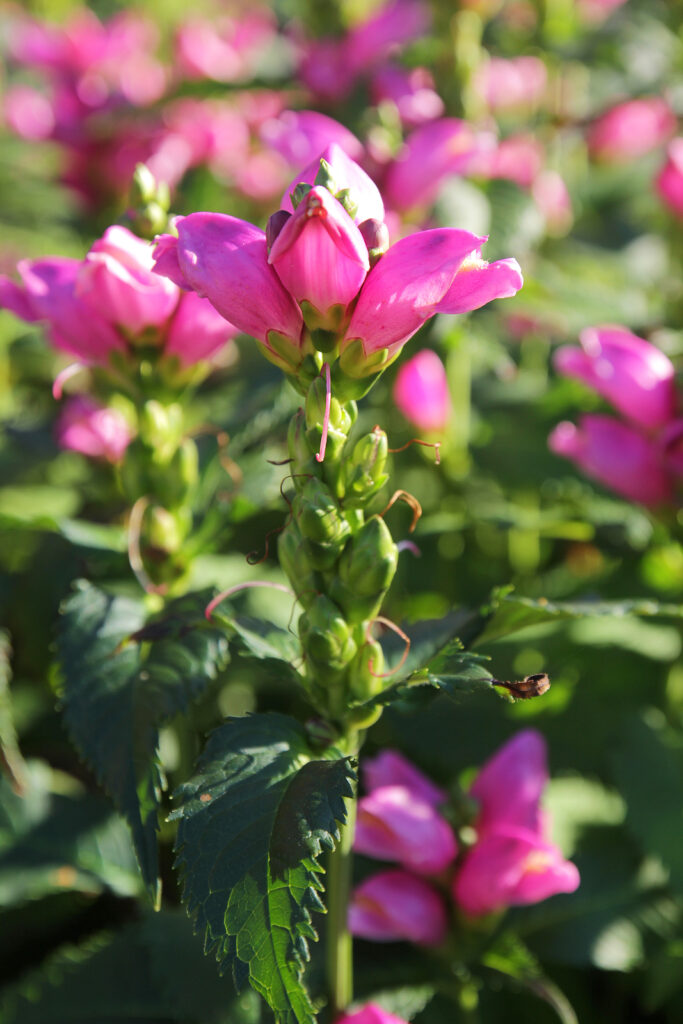Chelone, commonly called pink turtlehead, is a bushy perennial with rose pink inflated, tubular flowers that resemble the head of a turtle with jaws open. Chelone is a genus of about six species; all are native to moist woodland, prairies, and mountains.
Turtleheads have a stiff, upright habit. Flowers are borne in dense, terminal racemes from lae summer to mid-autumn.
Combine pink turtlehead with other perennials for late summer color.

Get to know Chelone
- Plant type: Perennial
- Growing Zones and range: Zones 3-8
- Hardiness: Hardy to -30°F (-34°C); intolerant of excessive heat
- Height and width: 12 to 36 inches (30-90cm) tall, 12 to 24 inches wide (30-60cm)
- Form: Bushy perennial to 3 feet tall; 4 to 7-inch leaves are broadly ovate with toothed margins
- Flowers: Tubular flowers that resemble the head of a turtle with jaws open
- Flower color: Pink and white
- Bloom time: Late summer
- Uses: Beds and borders
- Garden companions: combine with asters, phlox, and goldenrods
- Common name: Pink turtlehead
- Botanical name: Chelone species
- Family: Scrophulariaceae
- Origin: North America
Chelone uses and companions
- Plant Chelone in borders for late summer blooms.
- Naturalize Chelone in a bog garden or along a stream or pond.
- Good garden companions for Chelone include Aconitum, Anemone hybrida, Astilbe, Cimicifuga, Geranium, Hemerocallis.
Where to plant Chelone
- Plant pink turtlehead in full sun in wet regions. Plant in partial shade in drier conditions.
- Pink turtlehead prefers rich, slightly acid soil.
When to plant Chelone
- Set pink Chelone seedlings in the garden in spring.
- Start seed indoors two to three weeks before the last frost.

Planting and spacing Chelone
- Space pink turtlehead 12 to 24 inches (30-61cm) apart.
- Sow seed 1/8 inch deep in light potting mix or outdoors in evenly prepared planting beds.
How to water and feed Chelone
- Pink turtlehead prefers wet soil, even boggy conditions. Never let the soil dry out.
- Fertilize pink turtlehead with an all-purpose fertilizer in spring and every 4 to 6 weeks for best flowering.
Chelone care
- Stake plant growing in shade or if plants become rangy.
- Pink turtlehead is commonly pest and disease-free.
Chelone pests and diseases
- Chelone is susceptible to powdery mildew, rust, fungal leaf spots, and damage from slugs and snails.
Chelone propagation
- Divide crowns to reduce large clumps in older plants. Divide in spring or after flowering.
- Take stem cuttings in early summer.
- Sow seeds outdoors in fall or indoors in late winter.
- Chelone seeds germinate in 3 to 5 weeks at 65°F (18°C).

Chelone varieties to grow
- Chelone glabra has pinkish-white flowers and grows to 4 feet (1.2m); it is hardy in Zones 5-9
- Chelone lyonii has purple-pink flowers; grows to 4 feet tall; hardy in Zones 3-9.
- Chelone obliqua has deep pink or white flowers; it grows to 3 feet (.9m) tall and is hardy in Zones 3-9.















